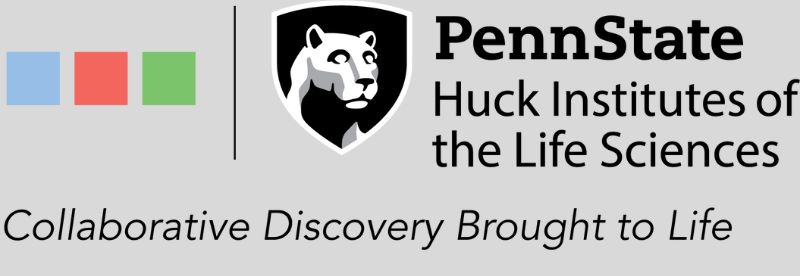By Holly Riddle

If you caught our profile on the Huck Institute of Life Sciences at Penn State earlier in the year, you may have been surprised by the article’s opening:
One might expect researchers across a single university to collaborate on a regular basis, regardless of expertise or department, but in truth, it often isn’t the case. Penn State is a notable exception — interdisciplinary research is one area where the university really shines. This fact was highlighted in a 2020 study on interdisciplinary research across the U.S. This recognition came, in large part, from the activities of the Huck Institutes of the Life Sciences at Penn State.
While those existing outside the realm of academia may think researcher collaboration is simply common sense, it’s actually not always the norm at educational institutions across the country. Instead, Penn State’s interdisciplinary institutes that “promote collaboration across departmental boundaries to focus research strengths on vital scientific questions and pressing societal needs” make the university stand out in a big way, benefitting everyone in the process, from students to researchers to industry.
To learn more about Penn State’s interdisciplinary institutes, we spoke with Penn State’s Professor Susan Trolier-McKinstry, an Evan Pugh University Professor and Steward S. Flaschen Professor of Ceramic Science and Engineering, and Professor of Electrical Engineering.
 Professor Susan Trolier-McKinstry, an Evan Pugh University Professor and Steward S. Flaschen Professor of Ceramic Science and Engineering, and Professor of Electrical Engineering, Penn State
Professor Susan Trolier-McKinstry, an Evan Pugh University Professor and Steward S. Flaschen Professor of Ceramic Science and Engineering, and Professor of Electrical Engineering, Penn State
Pushing the envelope
Could you tell us a little bit about your role and how it’s impacted by Penn State’s interdisciplinary institutes?
I am an Evan Pugh University professor of Material Science and Engineering, and actually a product of Penn State. I was a student here. I was trained in one of the very first interdisciplinary labs at the university and, subsequently, have made my career at the junction between material science and engineering and electrical engineering, physics, chemistry, acoustics and mechanical engineering, too. The ability to talk to people with all sorts of different backgrounds has been absolutely essential to the way that I work.
I have a relatively small core competence, but if you actually want to do good, interesting work, you have to push the envelope a little bit. One of the ways to do that is to work with people with different skillsets. That’s one of the things the interdisciplinary institutes are fantastic at. They take people outside of their discipline boundaries… Penn State learned how to do this very, very early as an institution, and it is one of our core strengths.
Why is this something that Penn State prioritized early on?
There were some really visionary people 40–50 years ago that were thinking about how to make research at Penn State more effective, more impactful and more useful to industry. How do we make it fulfill our land grant mission? Some of these people… believed in the interdisciplinary narrative and started it really early.
How do the interdisciplinary institutes benefit industry? What does that actually look like in real life?
There are a lot of answers to that. In my own work, I’m fundamentally a material scientist. I study how to make new materials, how to design them, and how to understand what properties they’re going to have — but this is only so useful if I throw a new material over the fence to industry and say, “You go figure out everything else.” [It’s] the ability to go from a new material to, well, let’s figure out how to do the processing science to integrate it into a device, and let’s talk to mechanical engineers and electrical engineers about how to optimize this device so that we can say not just that this could be interesting, but here’s exactly how interesting it will be.
The ability to go beyond the individual comfort zone of “I’m a material scientist and I design and make materials” to “Here’s how we could apply it and here’s what the reliability physics are” — that is really helpful to industry. Then, they’re not making as many guesses as to whether something will be useful at the other end. They can see how something actually behaves in a device and if the processing is something that could be done economically.
Are there any challenges to facilitating this interdisciplinary mindset and way of research?
The university made some very intentional decisions decades ago to eliminate the either-or way of counting things — that you can count it either for this department or for that department — and figured out how to give credit pretty broadly. That took away a huge structural barrier that’s present at some other institutions.
Are there still barriers to doing this? Yes, but some of them are inherent to the fact that, when you’re working with someone who has different training, we speak slightly different languages. It takes a while to figure out how to translate what I’m trying to do to the language that you need to hear, so that you can understand how to go to the next step.
Do you think Penn State would still have the research reputation that it does, if not for these interdisciplinary institutes?
We would still have some reputation. There is very important research that’s done within discipline boundaries, but it’s quite clear that Penn State’s reputation is amplified by our interdisciplinary research.
To what degree are the interdisciplinary institutes a selling point for students looking to come to Penn State?
When you go to industry, you’re going to end up working in a team and you’re going to have team members from different backgrounds. That’s how you do functional engineering. It doesn’t help to have only one opinion or only one viewpoint. You need everything to work to make a product that you can sell. Learning those life skills of working in groups where everyone’s background is different, is something that they can go away with and know is a crucial employable skill.
What would you say are some of the biggest impacts Penn State has made thanks to the interdisciplinary institutes?
I’ll give you one example. Penn State is extremely famous for ferroelectric materials. These are the materials that go into biomedical ultrasound transducers. It’s the heart of the medical transducer that’s used for ultrasound, for fetal monitoring or for heart monitoring. Ferroelectric capacitors are in every computer and every cell phone. Part of the reason Penn State became the epicenter for research [on ferroelectric materials] around the world was because there were physicists, material scientists, electrical engineers and mechanical engineers all thinking about these problems together. They were able to do much more than you could have done with any one skillset alone.
Anything else you wanted to mention about Penn State’s interdisciplinary institutes?
It’s just fun. It’s really fun when you can work at the interface of disciplinary boundaries and discover something new and actually do something that is going to be useful at the other end.






